Round Strand Wire Rope
Our wire ropes are crafted for high strength and durability, making them ideal for demanding applications such as mining, bridge construction, and ocean engineering.
Your Trusted Source For High-Quality Wire Ropes & Sling
As a specialized manufacturer and supplier, Aulone is committed to providing you with top-quality wire ropes and rigging products, engineered to meet rigorous industry standards. Our range includes various specifications, or we can create bespoke solutions tailored to your specific needs. With certifications like BV and CE, Aulone is your partner in advancing your projects with robust and reliable solutions.
Mian Structure
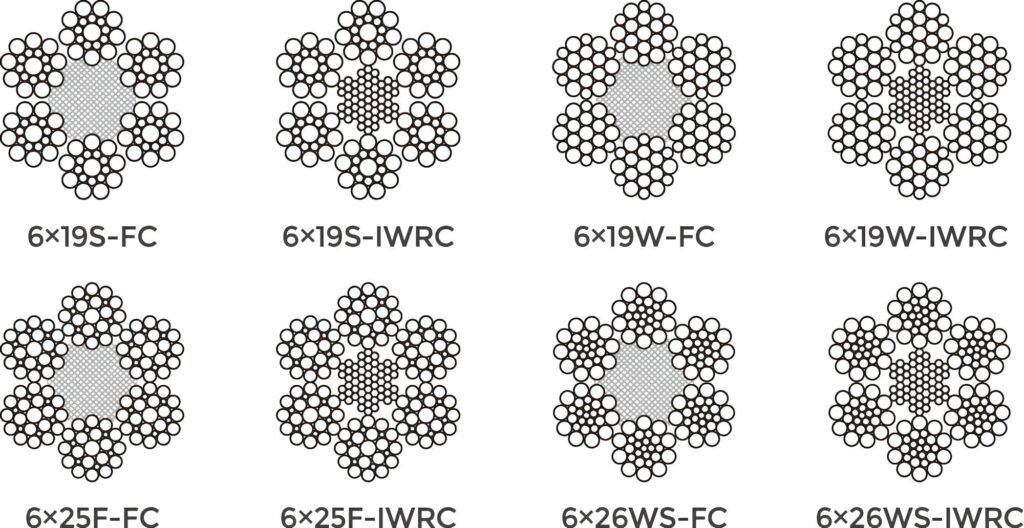
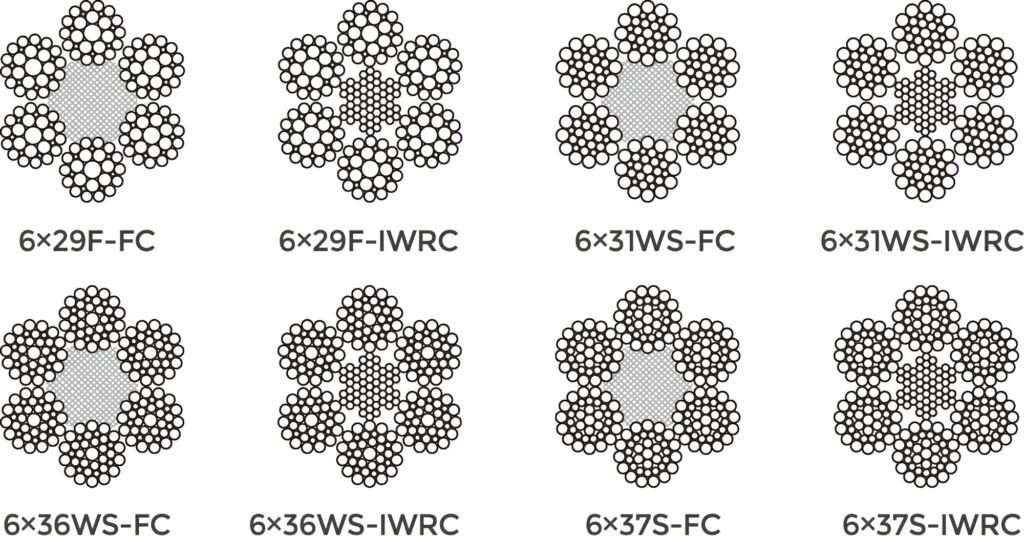
Rope type: 6×19, 6×25,6×26,6X36
Drawn galvanized standard wire rope (non rotation resistant with round wires), The independent wire rope core provides more strength and stability to the wire rope compared to fibre core. Parallel lay construction, long lifetime.
Our Advantage
Proven strand design and high adaptability.
High breaking force.
100% quality assurance, long service life.
Low maintenance, fair cost-benefit ratio.
In accordance with the EN 12385-4 standard.
Different constructions depending on the diameter.
Core:IWRC, Independent Wire Rope Core
Grade:1770mpa,1960mpa,2160mpa
Lay: sZ,zS,zZ,sS
Application: Hoisting rope, derricking rope, luffing rope, trolley rope, closing rope for general lifting applications.
Oil and gas application such as drilling lines, tubing lines, sand lines etc.
| Diameter (mm) | Approx. weight (kg/100m) | Tensile strength (MPa) | ||||||||
| 1570 | 1770 | 1960 | 2160 | |||||||
| Minimum breaking load (kN) | ||||||||||
| FC | WC | FC | WC | FC | WC | FC | WC | FC | WC | |
| 8 | 24.3 | 26.8 | 33.2 | 35.8 | 37.4 | 40.3 | 41.4 | 44.7 | 45.6 | 49.2 |
| 9 | 30.8 | 33.9 | 42 | 45.3 | 47.3 | 51 | 52.4 | 56.5 | 57.7 | 62.3 |
| 10 | 38.0 | 41.8 | 51.8 | 55.9 | 58.4 | 63 | 64.7 | 69.8 | 71.3 | 76.9 |
| 11 | 46.0 | 50.6 | 62.7 | 67.6 | 70.7 | 76.2 | 78.3 | 84.4 | 86.2 | 93 |
| 12 | 54.7 | 60.2 | 74.6 | 80.5 | 84.1 | 90.7 | 93.1 | 100 | 103 | 111 |
| 13 | 64.2 | 70.6 | 87.6 | 94.5 | 98.7 | 106 | 109 | 118 | 120 | 130 |
| 14 | 74.5 | 81.9 | 102 | 110 | 114 | 124 | 127 | 137 | 140 | 151 |
| 16 | 97.3 | 107 | 133 | 143 | 150 | 161 | 166 | 179 | 182 | 197 |
| 18 | 123 | 135 | 168 | 181 | 189 | 204 | 210 | 226 | 231 | 249 |
| 20 | 152 | 167 | 207 | 224 | 234 | 252 | 259 | 279 | 285 | 308 |
| 22 | 184 | 202 | 251 | 271 | 283 | 305 | 313 | 338 | 345 | 372 |
| 24 | 219 | 241 | 298 | 322 | 336 | 363 | 373 | 402 | 411 | 443 |
| 26 | 257 | 283 | 350 | 378 | 395 | 426 | 437 | 472 | 482 | 520 |
| 28 | 298 | 328 | 406 | 438 | 458 | 494 | 507 | 547 | 559 | 603 |
| 32 | 389 | 428 | 531 | 572 | 598 | 645 | 662 | 715 | 730 | 787 |
| 36 | 492 | 542 | 671 | 724 | 757 | 817 | 838 | 904 | 924 | 997 |
| 40 | 608 | 669 | 829 | 894 | 935 | 1010 | 1030 | 1120 | 1140 | 1230 |
| 44 | 736 | 809 | 1000 | 1080 | 1130 | 1220 | 1250 | 1350 | 1380 | 1490 |
| 48 | 876 | 963 | 1190 | 1290 | 1350 | 1450 | 1490 | 1610 | 1640 | 1770 |
| 52 | 1030 | 1130 | 1400 | 1510 | 1580 | 1700 | 1750 | 1890 | 1930 | 2080 |
| 56 | 1190 | 1310 | 1620 | 1750 | 1830 | 1980 | 2030 | 2190 | 2230 | 2410 |
| 60 | 1370 | 1500 | 1870 | 2010 | 2100 | 2270 | 2330 | 2510 | 2570 | 2770 |
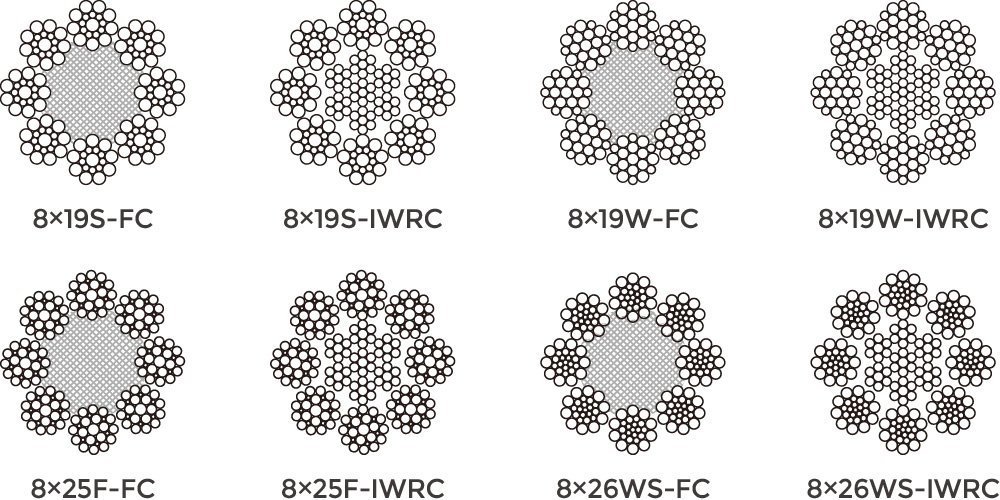
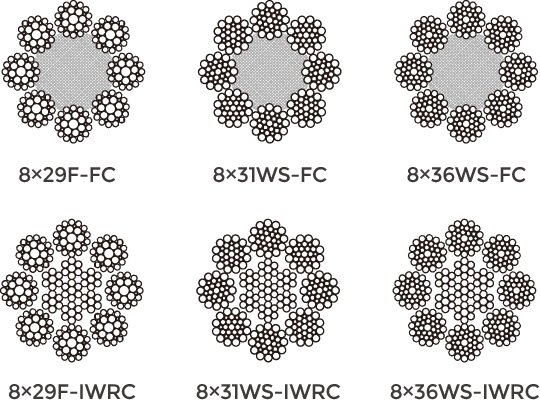
Series 8X19,8X26,8X36WS
Standard : EN 12385-4
Galvanized or ungalvanized is available.
Advantage
1. Flexible and solid rope construction.
2. Higher performance level compared to 6 series.
3. For use on single layer drums only.
4. Low maintenance costs, fair cost-benefit ratio.
Application: Hoisting rope, derricking rope, luffing rope, trolley rope, closing rope for general lifting applications.
Oil and gas application such as drilling lines, tubing lines, sand lines etc.
| Diameter (mm) | Approx. weight (kg/100m) | Tensile strength (MPa) | ||||||||
| 1570 | 1770 | 1960 | 2160 | |||||||
| Minimum breaking load (kN) | ||||||||||
| FC | WC | FC | WC | FC | WC | FC | WC | FC | WC | |
| 8 | 22.8 | 27.8 | 29.4 | 34.8 | 33.2 | 39.2 | 36.8 | 43.4 | 40.5 | 47.8 |
| 9 | 29.9 | 35.2 | 37.3 | 44.0 | 42.0 | 49.6 | 46.5 | 54.9 | 51.3 | 60.5 |
| 10 | 35.7 | 43.5 | 46.0 | 54.3 | 51.9 | 61.2 | 57.4 | 67.8 | 63.3 | 74.7 |
| 11 | 43.2 | 52.6 | 55.7 | 65.7 | 62.8 | 74.1 | 69.5 | 82.1 | 76.6 | 90.4 |
| 12 | 51.4 | 62.6 | 66.2 | 78.2 | 74.7 | 88.2 | 82.7 | 97.7 | 91.1 | 108.0 |
| 13 | 60.3 | 73.5 | 77.7 | 91.8 | 87.6 | 103.0 | 97.1 | 115.0 | 107.0 | 126.0 |
| 14 | 70.0 | 85.3 | 90.2 | 106.0 | 102.0 | 120.0 | 113.0 | 133.0 | 124.0 | 146.0 |
| 16 | 91.4 | 111 | 118 | 139 | 133 | 157 | 147 | 174 | 162 | 191 |
| 18 | 116 | 141 | 149 | 176 | 168 | 198 | 186 | 220 | 205 | 242 |
| 20 | 143 | 174 | 184 | 217 | 207 | 245 | 230 | 271 | 253 | 299 |
| 22 | 173 | 211 | 223 | 263 | 251 | 296 | 278 | 328 | 306 | 362 |
| 24 | 206 | 251 | 265 | 313 | 299 | 353 | 331 | 391 | 365 | 430 |
| 26 | 241 | 294 | 311 | 367 | 351 | 414 | 388 | 458 | 428 | 505 |
| 28 | 280 | 341 | 361 | 426 | 407 | 480 | 450 | 532 | 496 | 586 |
| 32 | 366 | 445 | 471 | 556 | 531 | 627 | 588 | 694 | 648 | 765 |
| 36 | 463 | 564 | 596 | 704 | 672 | 794 | 744 | 879 | 820 | 969 |
| 40 | 571 | 696 | 736 | 869 | 830 | 980 | 919 | 1090 | 1010 | 1200 |
| 44 | 691 | 842 | 891 | 1050 | 1000 | 1190 | 1110 | 1310 | 1230 | 1450 |
| 48 | 823 | 1000 | 1060 | 1250 | 1190 | 1410 | 1320 | 1560 | 1460 | 1720 |
| 52 | 965 | 1180 | 1240 | 1470 | 1400 | 1660 | 1550 | 1830 | 1710 | 2020 |
| 56 | 1120 | 1360 | 1440 | 1700 | 1630 | 1920 | 1800 | 2130 | 1980 | 2340 |
| 60 | 1290 | 1570 | 1660 | 1960 | 1870 | 2200 | 2070 | 2440 | 2280 | 2690 |
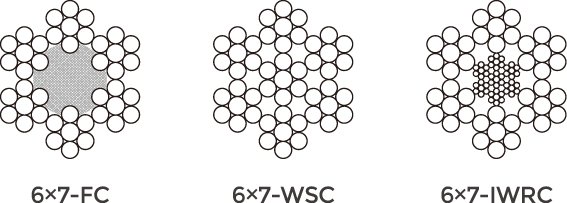
Advantage
Proven strand design and high adaptability.
Wear resistance – large outer.
Excellent spooling.
Low maintenance costs, fair cost-benefit ratio.
Resistance to kinking
Application: Hoisting rope, derricking rope, luffing rope, trolley rope, closing rope for general lifting applications.
Oil and gas application such as drilling lines, tubing lines, sand lines etc.
| Diameter (mm) | Approx. weight (kg/100m) | Tensile strength (MPa) | ||||||
| 1570 | 1770 | 1960 | ||||||
| Minimum breaking load (kN) | ||||||||
| mm | FC | WC | FC | WC | FC | WC | FC | WC |
| 2 | 1.40 | 1.55 | 2.08 | 2.25 | 2.35 | 2.54 | 2.60 | 2.81 |
| 3 | 3.16 | 3.48 | 4.69 | 5.07 | 5.29 | 5.72 | 5.86 | 6.33 |
| 4 | 5.62 | 6.19 | 8.34 | 9.02 | 9.4 | 10.2 | 10.4 | 11.3 |
| 5 | 8.78 | 9.68 | 13.0 | 14.1 | 14.7 | 15.9 | 16.3 | 17.6 |
| 6 | 12.6 | 13.9 | 18.8 | 20.3 | 21.2 | 22.9 | 23.4 | 25.3 |
| 7 | 17.2 | 19.0 | 25.5 | 27.6 | 28.8 | 31.1 | 31.9 | 34.5 |
| 8 | 22.5 | 24.8 | 33.4 | 36.1 | 37.6 | 40.7 | 41.6 | 45.0 |
| 9 | 28.4 | 31.3 | 42.2 | 45.7 | 47.6 | 51.5 | 52.7 | 57.0 |
| 10 | 35.1 | 38.7 | 52.1 | 56.4 | 58.8 | 63.5 | 65.1 | 70.4 |
| 11 | 42.5 | 46.8 | 63.1 | 68.2 | 71.1 | 76.9 | 78.7 | 85.1 |
| 12 | 50.5 | 55.7 | 75.1 | 81.2 | 84.6 | 91.5 | 93.7 | 101 |
| 13 | 59.3 | 65.4 | 88.1 | 95.3 | 99.3 | 107 | 110 | 119 |
| 14 | 68.8 | 75.9 | 102 | 110 | 115 | 125 | 128 | 138 |
| 16 | 89.9 | 99.1 | 133 | 144 | 150 | 163 | 167 | 180 |
| 18 | 114 | 125 | 169 | 183 | 190 | 206 | 211 | 228 |
| 20 | 140 | 155 | 208 | 225 | 235 | 254 | 260 | 281 |
| 22 | 170 | 187 | 252 | 273 | 284 | 308 | 315 | 341 |
| 24 | 202 | 223 | 300 | 325 | 338 | 366 | 375 | 405 |
| 26 | 237 | 262 | 352 | 381 | 397 | 430 | 440 | 476 |
| 28 | 275 | 303 | 409 | 442 | 461 | 498 | 510 | 552 |
| 30 | 316 | 348 | 469 | 507 | 529 | 572 | 586 | 633 |
| 32 | 359 | 396 | 534 | 577 | 602 | 651 | 666 | 721 |
| 34 | 406 | 447 | 603 | 652 | 679 | 735 | 752 | 813 |
| 36 | 455 | 502 | 676 | 730 | 762 | 824 | 843 | 912 |
| 40 | 562 | 619 | 834 | 902 | 940 | 1020 | 1041 | 1130 |
| 44 | 680 | 749 | 1010 | 1090 | 1140 | 1230 | 1260 | 1360 |
Your Ultimate Guide to Acquiring Round Strand Wire Rope
Acquiring round strand wire rope involves understanding its specifications, selecting the right type for your application, and sourcing it from reliable suppliers. Here’s your ultimate guide to help you through the process:
Table of contents
Chapt 1
What is Round Strand Wire Rope

Round strand wire rope is a type of cable made by twisting several strands of metal wire together around a core in a helical pattern. This design is one of the most common configurations for wire ropes, known for its balance of flexibility and strength. The term “round strand” refers to the round cross-sectional arrangement of the strands, making the rope relatively flexible and resistant to bending fatigue.
Components of Round Strand Wire Rope
Wires: Individual metal wires, typically made from high-carbon steel, which are the smallest components of the rope. These wires are drawn to specific diameters before being twisted into strands.
Strands: Several wires twisted together form a strand. The number of wires can vary depending on the desired strength and flexibility of the rope.
Core: The center around which the strands are coiled. Cores can be made from various materials, including metal (usually steel), natural fibers, or synthetic fibers. The core supports the strands and can contribute to the overall flexibility and strength of the rope.
Construction Types
The construction of round strand wire rope can be categorized into two main types based on the direction of the wire and strand twists:
Regular Lay: The wires are twisted in one direction, and the strands are twisted in the opposite direction around the core. This construction type provides good balance, stability, and resistance to external abrasion.
Lang Lay: Both wires and strands are twisted in the same direction. This arrangement offers smoother contact surfaces, making it more flexible and resistant to wear and compression under certain conditions.
Chapt 2
Advantage of Round Strand Wire Rope
Round strand wire rope offers several advantages over other types of ropes, making it a preferred choice for many applications. Here are some key advantages:
High Strength: Round strand wire rope is designed to withstand heavy loads and high tensile forces, making it suitable for lifting, pulling, and supporting heavy objects without breaking or deforming.
Flexibility: Despite its strength, round strand wire rope remains flexible, allowing it to bend and conform to various shapes and configurations. This flexibility makes it ideal for use with pulleys, winches, and other mechanical systems.
Resistance to Bending Fatigue: Round strand wire rope is highly resistant to bending fatigue, which occurs when a rope is repeatedly bent or flexed. This property ensures long-term durability and reliability, even under continuous use.
Abrasion Resistance: The helical construction of round strand wire rope provides excellent resistance to abrasion, making it suitable for use in harsh environments where the rope may come into contact with rough surfaces or abrasive materials.
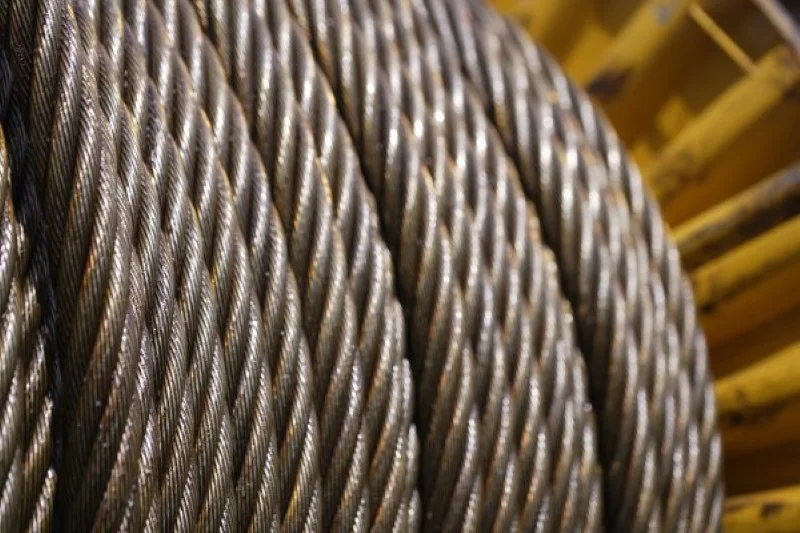
Versatility: Round strand wire rope is available in a wide range of sizes, constructions, and materials to suit various applications. It can be customized with different coatings, fittings, and configurations to meet specific requirements.
Reliability: Round strand wire rope is known for its reliability and consistency in performance. When properly maintained and used within its specified limits, it can provide years of dependable service in demanding conditions.
Corrosion Resistance: Depending on the material used (such as stainless steel or galvanized steel), round strand wire rope can offer excellent corrosion resistance, making it suitable for use in marine environments or other corrosive settings.
Ease of Handling: Round strand wire rope is relatively easy to handle and install, especially when compared to rigid materials like steel bars or rods. It can be spooled, coiled, and manipulated into various configurations with minimal effort.
Cost-Effectiveness: While round strand wire rope may have a higher initial cost compared to other types of ropes, its durability, longevity, and low maintenance requirements often make it a cost-effective choice over the long term.
Overall, the advantages of round strand wire rope make it a versatile and reliable solution for a wide range of applications in industries such as construction, mining, marine, transportation, and aerospace. Its combination of strength, flexibility, and durability makes it an indispensable tool for lifting, rigging, and securing heavy loads in diverse settings.
Chapt 3
What Factors Should Be Considered When Selecting Round Strand Wire Rope ?
When selecting round strand wire rope for a specific application, it’s crucial to consider a variety of factors to ensure optimal performance, safety, and durability. Here’s a detailed guide on what to evaluate:
1. Load Capacity
- Static and Dynamic Loads: Understand the maximum load the rope must support along with any dynamic forces it might encounter due to movement or environmental conditions.
- Safety Factor: Choose a rope with a safety factor appropriate for the type of load (static or dynamic) and the severity of service conditions.
2. Environmental Conditions
- Corrosion: Consider the presence of corrosive elements like saltwater or chemicals, which may necessitate a rope made from corrosion-resistant materials like stainless steel or galvanized wire.
- Temperature: High or low temperatures can affect the strength and flexibility of the rope. Ensure the selected rope can perform under the operating temperatures of the environment.
3. Abrasion Resistance
- Contact Surfaces: Evaluate the type of surfaces or materials the rope will contact during use. Rough surfaces require ropes with higher abrasion resistance.
- External Wear and Tear: Consider ropes with an outer layer of compacted strands or special coatings if high abrasion is expected.
4. Flexibility Requirements
- Bending Radius: The rope must be flexible enough to bend around the machinery’s sheaves and drums without excessive stress or wear.
- Fatigue Resistance: Frequent bending or cyclic loading requires a rope with high fatigue resistance to avoid premature failure.
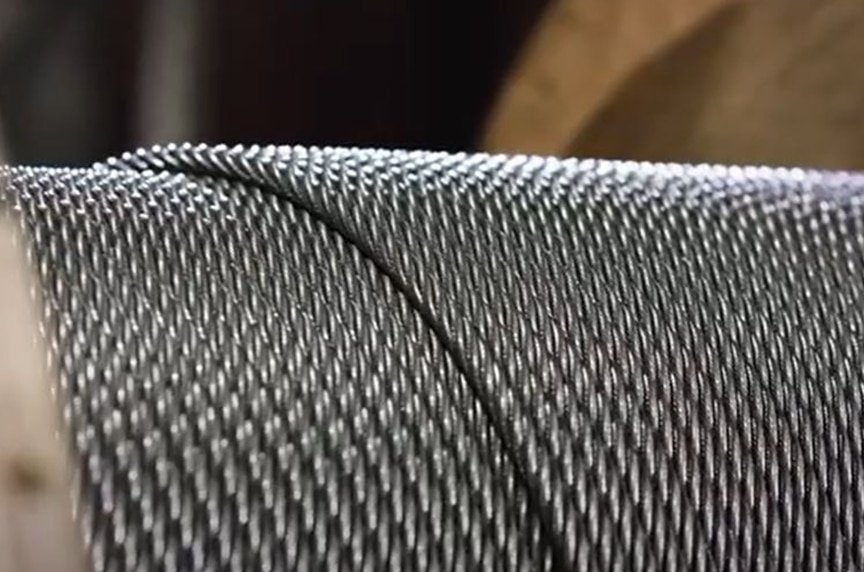
5. Rope Construction and Lay
- Strand and Core Configuration: The arrangement of wires and strands and the type of core (fiber core or independent wire rope core, IWRC) can significantly affect rope characteristics.
- Regular Lay vs. Lang Lay: Regular lay ropes are more stable and resistant to rotation, while lang lay ropes offer better wear resistance and are generally more flexible.
6. Diameter and Length
- Rope Diameter: Ensure the rope diameter is compatible with the equipment, such as pulleys and winches.
- Length: Confirm that the length is sufficient for the application, considering some extra for attachments and potential future adjustments.
7. Material and Coatings
- Wire Material: High-carbon steel is common, but stainless steel or other alloys might be needed for specific environments.
- Coatings: Zinc or other protective coatings can enhance corrosion resistance and durability.
8. Compliance with Standards
- Industry Standards: Ensure the rope meets industry standards like ISO, ASTM, or specific regulatory requirements relevant to the application (e.g., offshore, mining, construction).
9. Supplier Reliability
- Quality Assurance: Choose a supplier known for high-quality products and reliability. Confirm that they provide test certificates and product traceability.
- Technical Support: A supplier’s ability to offer technical guidance and support can be invaluable in selecting the right rope.
By carefully evaluating these factors, you can select a round strand wire rope that not only meets the specific needs of your application but also offers the best balance of performance, longevity, and cost.
Chapt 4
Application Of Round Strand Wire Rope
Round strand wire rope finds a wide range of applications across various industries due to its strength, flexibility, and durability. Here are some common applications:
Lifting and Rigging
- Cranes: Round strand wire rope is used for hoisting and lowering heavy loads in construction, shipping ports, and industrial facilities.
- Hoists: It is employed in electric, manual, and hydraulic hoists for lifting and positioning loads in warehouses, manufacturing plants, and construction sites.
- Lifting Equipment: Wire rope slings and assemblies are used for lifting and rigging operations in construction, mining, and offshore industries.
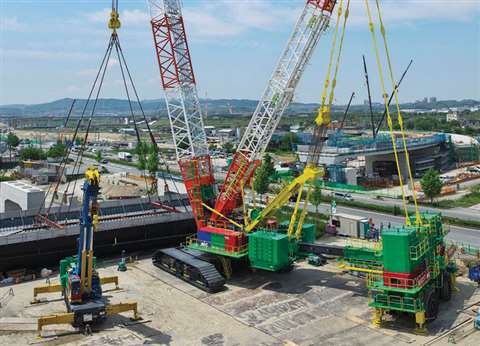
Marine and Offshore
- Mooring Lines: Round strand wire rope is used to secure ships, barges, and offshore platforms to docks, anchors, and buoys.
- Towing and Salvage: It is employed for towing vessels, barges, and floating structures in ports, harbors, and offshore operations.
- Offshore Rigging: Wire rope is used for rigging and lifting heavy equipment and materials on offshore oil rigs and platforms.

Mining And Quarrying
- Mine Hoists: Wire rope is used in mine hoists and shaft conveyances for transporting miners, equipment, and ore in underground mines.
- Haulage Systems: It is employed in haulage systems, including draglines, shovels, and conveyor systems, for moving materials in surface mining operations.
- Quarrying Equipment: Round strand wire rope is used in quarrying equipment such as cranes, excavators, and wire saws for cutting and moving stone blocks.
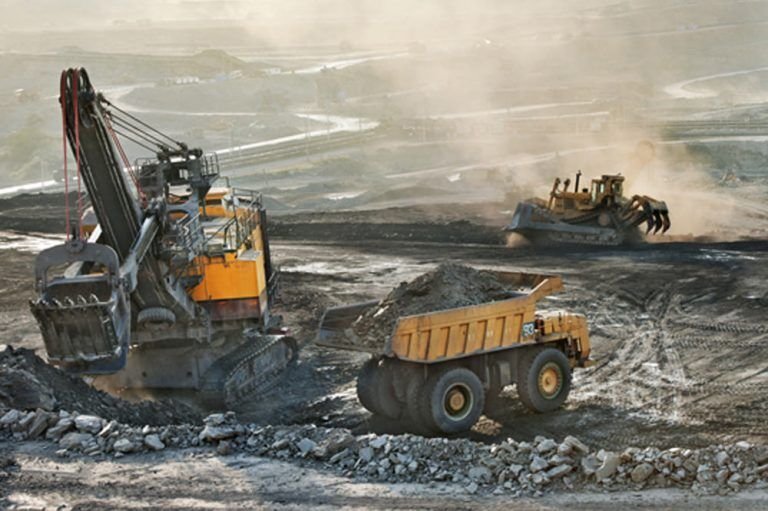
Construction and Infrastructure
- Tower Cranes: Wire rope is a critical component of tower cranes used in high-rise construction for lifting and moving construction materials.
- Suspension Bridges: It is used in suspension cables for supporting the weight of the bridge deck and providing stability.
- Scaffolding Systems: Wire rope is employed in suspension scaffolding systems for accessing and working at heights during construction and maintenance activities.

Round strand wire rope’s versatility, strength, and reliability make it indispensable in various industrial, commercial, and recreational applications where lifting, pulling, and securing heavy loads are required. Its adaptability to different environments and operating conditions make it a preferred choice across diverse industries worldwide.
Chapt 5
How Do You Inspect And Maintain Round Strand Wire Rope?
Inspecting and maintaining round strand wire rope is essential to ensure its continued safe and effective operation. Here’s a guide on how to inspect and maintain round strand wire rope properly:
1. Regular Visual Inspection:
Frequency: Conduct visual inspections regularly, ideally before each use and at scheduled intervals depending on the frequency and severity of use.
Check for Wear and Damage: Look for signs of wear, corrosion, broken wires, kinks, abrasion, or deformation along the entire length of the rope.
Inspect Attachments: Examine attachments, such as end fittings, thimbles, and splices, for wear, distortion, or signs of loosening.
Check for Lubrication: Ensure proper lubrication along the length of the rope to prevent corrosion and reduce friction.
2. Non-Destructive Testing (NDT):
Ultrasonic Testing: Use ultrasonic equipment to detect internal flaws, such as broken wires or core degradation, without damaging the rope.
Magnetic Particle Inspection (MPI): Employ MPI to detect surface and near-surface flaws caused by fatigue, wear, or corrosion.
Eddy Current Testing: Use eddy current techniques to identify cracks, corrosion, or material loss in ferrous and non-ferrous materials.
3. Load Testing:
Periodic Load Testing: Perform load testing at regular intervals to verify the rope’s strength and integrity.
Follow Manufacturer Recommendations: Adhere to the manufacturer’s guidelines for load testing procedures and equipment to ensure accurate results.
Document Test Results: Maintain records of load testing results for future reference and comparison.
4. Lubrication and Maintenance:
Regular Lubrication: Apply a suitable lubricant to the wire rope to reduce friction, prevent corrosion, and extend its lifespan. Use a lubricant recommended by the manufacturer.
Clean the Rope: Remove dirt, debris, and contaminants from the rope regularly to prevent abrasive wear and corrosion.
Inspect and Replace Seals: Check seals and lubrication systems for proper function and integrity. Replace damaged or worn seals as needed to prevent moisture ingress.
Follow Lubrication Schedule: Adhere to a regular lubrication schedule based on operating conditions, environment, and manufacturer recommendations.
5. Retiring Criteria:
Establish Criteria for Retirement: Define specific criteria for retiring wire rope based on factors such as wear, corrosion, loss of strength, or reaching the end of its service life.
Follow Industry Guidelines: Refer to industry standards and guidelines for determining retirement criteria and replacement intervals.
Consult Manufacturer Recommendations: Consider the manufacturer’s recommendations for retiring wire rope based on its design, material, and intended use.
6. Training and Personnel:
Train Personnel: Ensure that personnel responsible for inspecting and maintaining wire rope are trained in proper inspection techniques, equipment operation, and safety protocols.
Provide Resources: Equip personnel with the necessary tools, equipment, and resources to conduct thorough inspections and maintenance activities effectively.
By following these guidelines and implementing a comprehensive inspection and maintenance program, you can ensure the continued safety, reliability, and longevity of round strand wire rope in your applications. Regular inspection, proper lubrication, and adherence to manufacturer recommendations are key to maximizing the rope’s performance and minimizing the risk of accidents or failures.
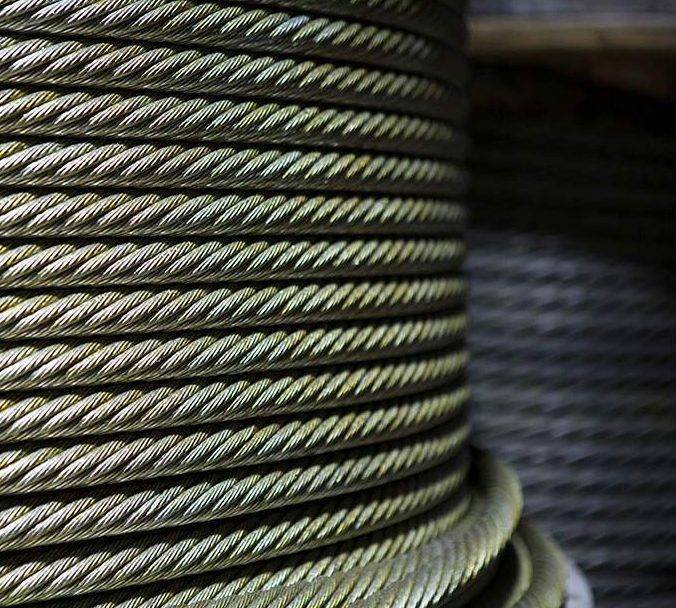
Chapt 6
Quality Assurance For Round Strand Wire Rope
Quality assurance is paramount in the production of round strand wire rope to ensure its reliability, safety, and performance. Here’s how quality assurance is implemented throughout the manufacturing process
1. Raw Material Inspection:
- Incoming Inspection: Raw materials, typically high-carbon steel wire rods, undergo rigorous inspection upon arrival. This includes checking dimensions, chemical composition, and surface condition to ensure they meet specified standards.
- Material Traceability: Each batch of raw material is assigned a unique identification code, allowing for traceability throughout the manufacturing process.
2. Production Process Control:
- Process Parameters Monitoring: Critical parameters such as wire drawing speed, stranding tension, and core lubrication are closely monitored and controlled to maintain consistency and quality.
- Quality Control Checks: Regular inspections are conducted at each stage of production to identify any deviations from specifications. This includes visual inspections, dimensional checks, and mechanical testing.
3. Stranding and Closing:
- Strand Consistency: During stranding and closing, machines are calibrated to ensure uniform twist rates and strand tension. This prevents variations in rope structure that could compromise strength and flexibility.
- Core Alignment: Proper alignment of the core and strands is crucial for maintaining rope integrity. Automated systems are often used to ensure accurate positioning and alignment.
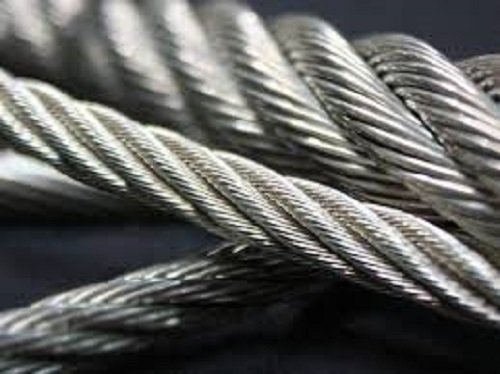
4. Lubrication and Coating:
- Uniform Lubrication: Lubrication is applied evenly throughout the rope to minimize internal friction and protect against corrosion. Automated systems are employed to ensure consistent lubricant application.
- Coating Inspection: If the rope receives additional coatings (e.g., zinc galvanizing), coating thickness is monitored to ensure adequate protection against corrosion.
5. End Termination and Finishing:
- Quality of End Terminations: End terminations, such as splices or sockets, undergo stringent quality checks to verify proper installation and secure attachment.
- Surface Inspection: Finished wire rope undergoes a final surface inspection to detect any defects or imperfections that may have occurred during production.
6. Testing and Certification:
- Mechanical Testing: Wire rope samples are subjected to mechanical tests, including tensile strength, bending fatigue, and breaking load, to verify compliance with industry standards.
- Certification: Once production is complete, wire rope batches are issued with test certificates confirming adherence to specified standards and quality requirements.
7. Continuous Improvement:
- Feedback Mechanisms: Customer feedback and internal quality audits provide valuable insights for identifying areas of improvement in the production process.
- Training and Skill Development: Ongoing training programs ensure that production staff are equipped with the necessary skills and knowledge to maintain high-quality standards.
By implementing robust quality assurance measures throughout the manufacturing process, round strand wire rope manufacturers can consistently deliver products that meet or exceed customer expectations and industry standards for quality and performance.
Get the catalogue
Leave a request and we will send you the catalogue with Aulone steel wire ropes by e-mail
86-15573139663
86-15363044363


